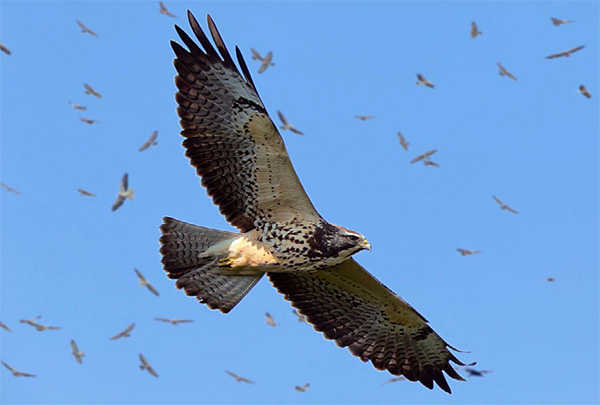By Beth King

A juvenile Swainson’s hawk flies by Panama City’s Ancon Hill on Sun, Nov. 2 during a record-setting raptor migration. (Photo courtesy Rafael Lau)
More than two million migrating raptors passed over Panama City on Sunday, Nov. 2, doubling the previous record of almost 900,000 tallied in a single day last year. This season at least three million raptors flew over Panama City on their thousand-kilometer journey from North to South America. This figure is also a record-setter in the annual tallies kept by the Audubon Society of Panama since 2004.
“The official count from Sunday’s massive raptor migration is 2,105,060 birds, most of them Turkey vultures and Swainson’s hawks,” said George Angehr, a Smithsonian ornithologist and authority on Panama’s birdlife. “A large percentage of the world population of Swainson’s hawks probably passed through on their way from the Great Plains to Argentina.”
This one-day total may also be the single largest recorded in the Americas. The season totals may also tie Panama with the world’s second-largest destination for raptor migrations in Eilat, Israel, which sees three million yearly. Spotters in Veracruz, Mexico estimate that some five million raptors per year pass through. Few other places in the world count a million raptors in a single migration.
“It’s a record that will leave us asking for a long time: What happened? Why so many birds?” Panama’s Audubon posted on its Facebook page.
Bad weather in Central America may create a bottleneck, limiting migration when it is rainy or cloudy, said Angehr. “When you get good flying conditions after several days of rain, they take advantage,” he said. “There must have been at least 100 miles of raptors. There was a river of birds passing all day.”
Raptors conserve energy during migration by riding columns of warm air that only form over land. Because the Isthmus of Panama is so narrow, birds are forced together and are easily seen. While the majority of the raptors are vultures and Swainson’s hawks, expert birders may spot some 20 species.
“These birds migrate by day and at night they need the forests that we have around the city — the humid forests and also the mangrove forests,” Rosabel Miró, the executive director of the Audubon in Panama, told news station TVN-2. She added this reinforces the need for legislation to protect the mangroves of the Bay of Panama.
The count, sponsored by Fundación Natura, is carried out from Oct. 1 to Nov. 18 on Ancon Hill, the landmark at the Pacific gateway to the Panama Canal.





